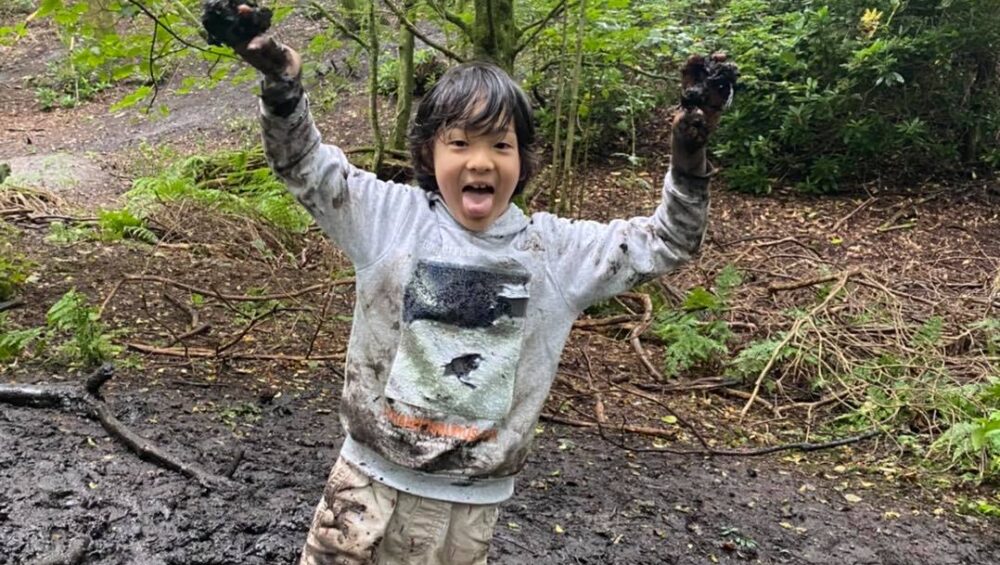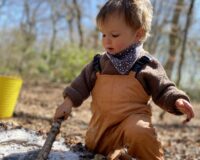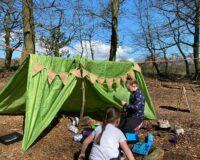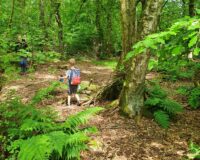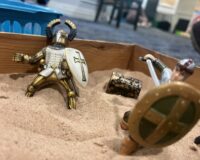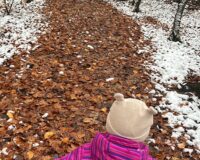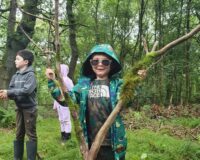“The world is mud-luscious and puddle-wonderful!” – E.Cummings
My childhood was simple. Some might even say boring. I was a young child in the ‘70s. Money was tight at home. Mum never knew from one week to the next what the price of a basket of groceries would be. Inflation was high. A time in some ways synonymous with now. We were lucky to afford a holiday in our caravan (made by my dad, I kid you not!) but we certainly
couldn’t afford to go abroad. I remember the hot, sticky trips. The car was a khaki-coloured Maxi and my legs stuck like glue to the vinyl seats which left me with a dimply red rash. I went to Brownies but that was it. And I spent hours playing outside. They were happy days. Mud play is on my list of happy memories- mud slop with a squirt of washing up liquid (why I can’t remember, perhaps I should try it again), excavated mud clay models and digging in my own little patch of garden.
Why do I say all this? Because sometimes the simple and free activities are both timeless, priceless and precious. Something worth remembering in days when parents may be struggling financially. And it’s a lovely thought to hope and imagine that your child could also be making some beautiful memories whilst mixing mud, painting with the stuff, and stamping and digging in it! Our regular parents know that their children generally love playing in mud. Children may need to start small, maybe just a poke of a finger, but often before they know it, they would, if given permission, happily cover themselves from head to toe! Whatever their age. Over and over and over. The problem for most of our parents at least to begin with, is that they just don’t love it anywhere near as much! Indeed, some parents bravely come to our sessions with genuine worries about mud, and their child getting dirty, at the forefront of their minds. Especially given the last few years of germ preoccupation and hand gel. I get it and must confess, that even my own mucky childhood adventures didn’t predispose me to be laid back about dirt when it came to my own children. It’s DIRTY after all!
So, I’ve done a bit of research and I hope that what I’ve read might help the nervous amongst you and perhaps even those of you too unsure about the ‘dirty’ side of our sessions to give them a whirl.
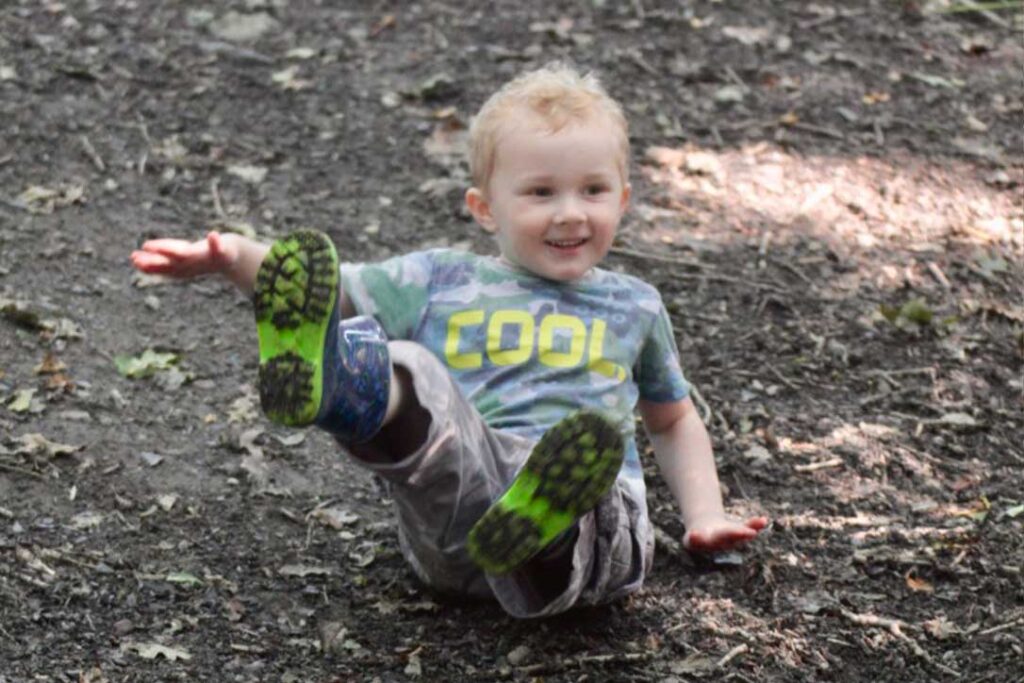

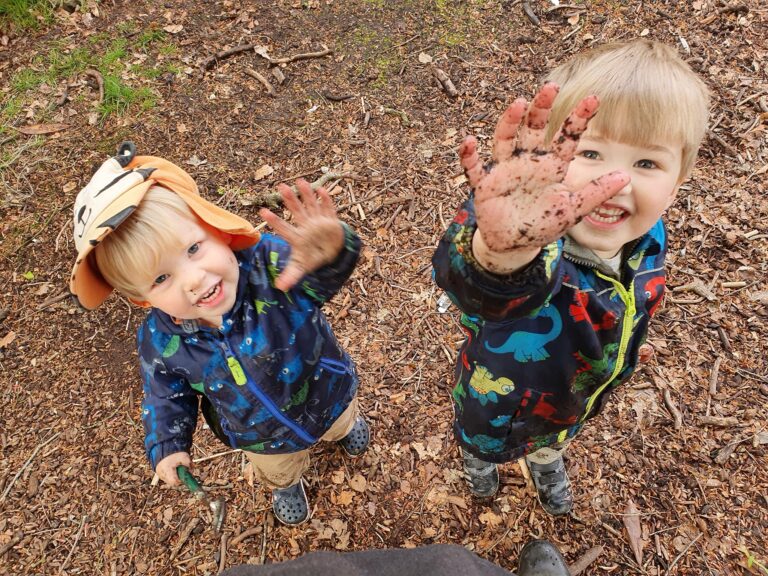
Playing in mud stimulates a healthy immune system to make healthy responses. Dr Jack Gilbert, microbiome specialist and author of “Dirt is Good” says this of children, “Their oral interaction with the microbial world helps to train their immune system to be more robust.” Frequent stimulation of the immune system is important and helps to lessen the risk of allergies. Now of course, we’re not suggesting that your babies consume it and of course it’s advisable to wash or clean hands before eating as it does contain bacteria (we’ll come back to that in a minute!) but touching it and playing with it is all good.
Bacteria! What? How can that be good? Yes, it’s true that there are bacteria of the not-so-good variety in mud (E.Coli being one possible culprit) but healthy children and adults can cope with them in the quantities present. And then there is Mycobacterium Vaccae a friendly soil bacterium which stimulates the immune system to release serotonin, an endorphin which regulates and boosts mood. Playing in mud makes children happy! It can reduce childhood anxiety and stress and lessen any susceptibilities to depression.
Mud increases brain activity because it engages ALL the senses. When this happens, the brain is highly stimulated and active. In addition, the same release of serotonin already mentioned has been shown to improve cognitive function. Sensory, hands-on play helps to develop children’s brains.
Mud play increases physical activity. Digging in it, stirring thick mud and painting it on a tree with a stick are all examples of activities which develop little muscles. Something which needs to happen before children can successfully hold a pencil to write with by the way.
Mud play develops creativity. It’s a fabulous art medium. It can be painted with, moulded and decorated. It can also be used in imaginative play to help create small worlds or represent other things. I regularly enjoy a muddy latte and a mud cake at the mud café!
Mud is an open-ended material that can be played with and enjoyed by children of all ages, meeting a range of different needs and interests. It is universally enjoyed by children of any age and from every culture.
Children develop an adventurous spirit through mud play. Sloshing, squelching, and sliding in mud are challenging activities which expand their experiences and build confidence.
I hope that you will agree that
any risks of playing in mud are far outweighed by the benefits! Here is a great
place to start for muddy ideas (and a free mud kitchen booklet too) https://muddyfaces.co.uk/outdoor-hub/mud
Mud play is an easy, affordable
but above all JOYFUL way to connect with nature! Try it yourself, if you
haven’t already, and I bet that you too will soon be enjoying making mud pies and
lots and lots of happy memories! The world is mud-luscious and puddle wonderful
after all!
By Heather Spencer – Trainee Forest School Leader


